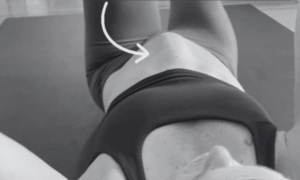Often nicknamed “ab separation”, DRA actually refers to the thinning and widening of the connective tissue in the middle of the abdominal wall between the rectus abdominis muscles, and the associated laxity of the abdominal wall.
Is it normal?
Slight separation towards the end of pregnancy should be considered normal – that baby has to fit somewhere! Usually this separation resolves naturally in the weeks following birth. However, for around a third of women, for unknown reasons, it doesn’t and is where the right treatment (aka evidence informed rehabilitation) is important.
What do I do if mine hasn’t resolved on its own?
If you are worried about the function or appearance of your abdominal wall (tummy) or are even just unsure if yours is persisting, make and appointment with a women’s health physio.
They will assess the width and depth of the gap, and how well you can activate your abdominal muscles. You will also be taught how to assess your own abdominal wall so you can monitor your own progress and ensure you are correctly engaging your muscles during your rehab exercises.
Should I avoid exercise while I have DRA?
Certainly not – contrary to what you may hear about DRA, movement isn’t “bad” or dangerous. Restricting exercise frequency and intensity actually leads to weakening muscles around the whole body, including the abdominal wall You should still maintain an active lifestyle and engage in exercises you enjoy – it’s just a matter of doing them safely, which your women’s health physio will talk you through. Upright and functional exercises are great especially for busy mums. You can even start with actively ‘switching on’ your abdominal wall when doing daily chores, like hanging the washing.
The key is to begin with movements that don’t cause ‘doming’ such as sit ups – see image below:
Tips for moving beyond the gap:
- Aim to strengthen the entire abdominal wall with balanced exercises.
- Goal setting: start small and set individual goals to keep you motivated.
- Avoid constipation and straining: straining with constipation puts unnecessary pressure on our abdominal wall and pelvic floor. Modify your diet and sit in a good position on the toilet when you’re opening your bowels – a foot stool can help with this!
- Hernias – some women may also have an umbilical hernia with DRA. Most hernias are harmless and do not cause any issues. If you think you have a hernia, you should get it checked by your GP.
- Remember that physical activity is important for your overall mental and physical health.
- Don’t fear load – abdominal load refers to the difficulty and effort of exercise applied to the abdominal wall. The right amount of load is an important part of improving DRA, just don’t overdo it and use the right methods.
- Posture – being able to vary and move between different postures is important. Posture has been proven to influence how we feel, with more upright postures encouraging positive feelings, and slumped postures encouraging negative feelings. As DFFA can be associated with lower self esteem and body image, posture may be beneficial to consider in trying to counteract this.
- Diet and nutrition – healing tissue requires adequate nutrients and vitamins. Eating a well balanced diet will optimise your recovery.


